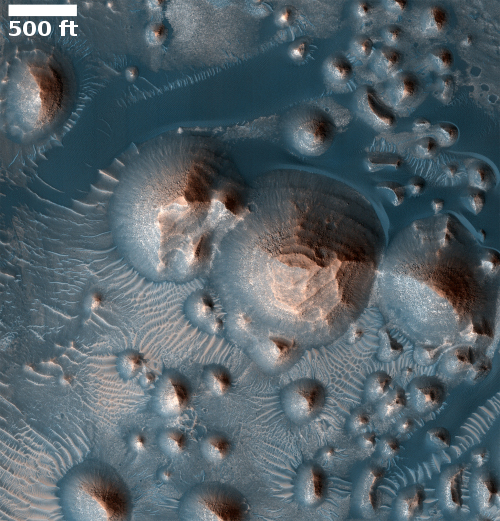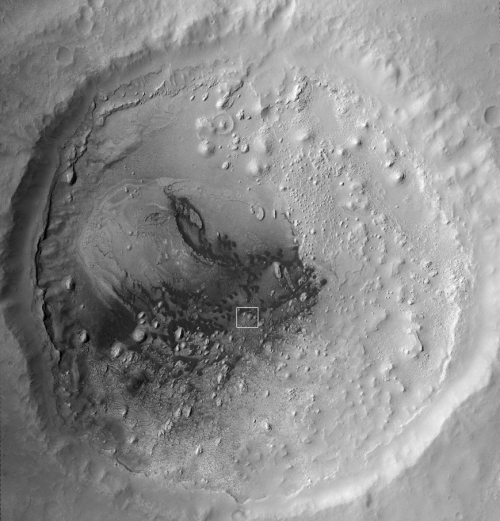Terraced mesas in Martian crater

Click for full resolution image.
The cool image to the right, reduced and annotated to post here, was a captioned photo released by the Mars Reconnaissance Orbiter (MRO) science team earlier this week. Taken by MRO’s high resolution camera, it shows in color a beautifully stair-stepped mesa located in an unnamed 22-mile-wide equatorial crater in Arabia Terra, the large transitional zone between the lowland northern plains and the southern cratered highlands. As the caption notes,
Several craters in Arabia Terra are filled with layered rock, often exposed in rounded mounds. The bright layers are roughly the same thickness, giving a stair-step appearance. The process that formed these sedimentary rocks is not yet well understood. They could have formed from sand or volcanic ash that was blown into the crater, or in water if the crater hosted a lake.
If volcanic ash, the layers are signalling a series of equal eruptions of equal duration, which seems unlikely. Water is also puzzling because of the equatorial location. Like yesterday’s mystery cool image, water is only likely here at a time when the red planet’s rotational tilt, its obliquity, was much higher, placing this at a higher latitude than it is today.
Regardless, make sure you look at the full image here. This crater floor is chock-full of more such terraced mesas, some of which are even more striking than the sample above.
I have also posted below the MRO context camera photo of the entire crater.
The white box indicates the location of the mesas above.
To my eye, the floor of this crater suggests that it was once water- or ice-filled, with the low point and last area where water/ice existed the crater’s northwest quadrant. The areas to the east and south would have experienced I think repeated exposures and then burials by that water/ice as that material slowly sublimated away over many cycles of slow retreat. It was this repeated process that would have created the stair-stepped terraces.
In a sense, we might be looking at the final product of a crater that was once glacier-filled (like the many found today in the Martian mid-latitudes) but now devoid of any H2O.
The dark streaks by the way are wind-blown sand ponds and dunes, as shown in this high resolution MRO image. Apparently the sand is being piled up against cliff faces and along what appear to be now dry drainage paths, following the grade downward to the crater floor’s low point in the northwest quadrant.
On Christmas Eve 1968 three Americans became the first humans to visit another world. What they did to celebrate was unexpected and profound, and will be remembered throughout all human history. Genesis: the Story of Apollo 8, Robert Zimmerman's classic history of humanity's first journey to another world, tells that story, and it is now available as both an ebook and an audiobook, both with a foreword by Valerie Anders and a new introduction by Robert Zimmerman.
The print edition can be purchased at Amazon or from any other book seller. If you want an autographed copy the price is $60 for the hardback and $45 for the paperback, plus $8 shipping for each. Go here for purchasing details. The ebook is available everywhere for $5.99 (before discount) at amazon, or direct from my ebook publisher, ebookit. If you buy it from ebookit you don't support the big tech companies and the author gets a bigger cut much sooner.
The audiobook is also available at all these vendors, and is also free with a 30-day trial membership to Audible.
"Not simply about one mission, [Genesis] is also the history of America's quest for the moon... Zimmerman has done a masterful job of tying disparate events together into a solid account of one of America's greatest human triumphs."--San Antonio Express-News

Click for full resolution image.
The cool image to the right, reduced and annotated to post here, was a captioned photo released by the Mars Reconnaissance Orbiter (MRO) science team earlier this week. Taken by MRO’s high resolution camera, it shows in color a beautifully stair-stepped mesa located in an unnamed 22-mile-wide equatorial crater in Arabia Terra, the large transitional zone between the lowland northern plains and the southern cratered highlands. As the caption notes,
Several craters in Arabia Terra are filled with layered rock, often exposed in rounded mounds. The bright layers are roughly the same thickness, giving a stair-step appearance. The process that formed these sedimentary rocks is not yet well understood. They could have formed from sand or volcanic ash that was blown into the crater, or in water if the crater hosted a lake.
If volcanic ash, the layers are signalling a series of equal eruptions of equal duration, which seems unlikely. Water is also puzzling because of the equatorial location. Like yesterday’s mystery cool image, water is only likely here at a time when the red planet’s rotational tilt, its obliquity, was much higher, placing this at a higher latitude than it is today.
Regardless, make sure you look at the full image here. This crater floor is chock-full of more such terraced mesas, some of which are even more striking than the sample above.
I have also posted below the MRO context camera photo of the entire crater.
The white box indicates the location of the mesas above.
To my eye, the floor of this crater suggests that it was once water- or ice-filled, with the low point and last area where water/ice existed the crater’s northwest quadrant. The areas to the east and south would have experienced I think repeated exposures and then burials by that water/ice as that material slowly sublimated away over many cycles of slow retreat. It was this repeated process that would have created the stair-stepped terraces.
In a sense, we might be looking at the final product of a crater that was once glacier-filled (like the many found today in the Martian mid-latitudes) but now devoid of any H2O.
The dark streaks by the way are wind-blown sand ponds and dunes, as shown in this high resolution MRO image. Apparently the sand is being piled up against cliff faces and along what appear to be now dry drainage paths, following the grade downward to the crater floor’s low point in the northwest quadrant.
On Christmas Eve 1968 three Americans became the first humans to visit another world. What they did to celebrate was unexpected and profound, and will be remembered throughout all human history. Genesis: the Story of Apollo 8, Robert Zimmerman's classic history of humanity's first journey to another world, tells that story, and it is now available as both an ebook and an audiobook, both with a foreword by Valerie Anders and a new introduction by Robert Zimmerman.
The print edition can be purchased at Amazon or from any other book seller. If you want an autographed copy the price is $60 for the hardback and $45 for the paperback, plus $8 shipping for each. Go here for purchasing details. The ebook is available everywhere for $5.99 (before discount) at amazon, or direct from my ebook publisher, ebookit. If you buy it from ebookit you don't support the big tech companies and the author gets a bigger cut much sooner.
The audiobook is also available at all these vendors, and is also free with a 30-day trial membership to Audible.
"Not simply about one mission, [Genesis] is also the history of America's quest for the moon... Zimmerman has done a masterful job of tying disparate events together into a solid account of one of America's greatest human triumphs."--San Antonio Express-News



Beautiful, some of those dune are miles high, perfect for skiing.
I’m sure some rich person will ship containers full of blue sand for there private resort.
“The healing power of blue crystal sand, all the way from Mars.”
I have not seen any pictures of any territory on Mars ( or any other planet except Earth ) that is as interesting and beautiful ! Why didn’t we send the rover there ? ! This area has to be checked out with a rover ASAP , perhaps a drone of some kind. Somebody make sure Musk sees these pictures ! And President Trump ! ( You could show Biden , but he wouldn’t understand or remember after a few minutes. )
Beautiful yes but it reminds me of looking at PCB board while repairing it under a microscope
Beautiful yes but it reminds me of looking at PCB board while repairing it under a microscope
I love the way the dunes have created fractal patterns, some radiating outward’s from the cone, others developing into a nearly complete circle.
To get a size comparison, the normal dunes which are huge, make a beautiful regular pattern but are microscopic compared to the mountain dunes. All on top of of a fractured bedrock that seems rather smooth.
There are semi circular peaks that surround two of the cones at equal distance. I believe this is evidence that the cones are meteor impacts on something soft that eroded away leaving the melted hardened impact site behind. I see no evidence of volcanic cinder cones, so meteor impact residue is the best explanation. (is my guess)